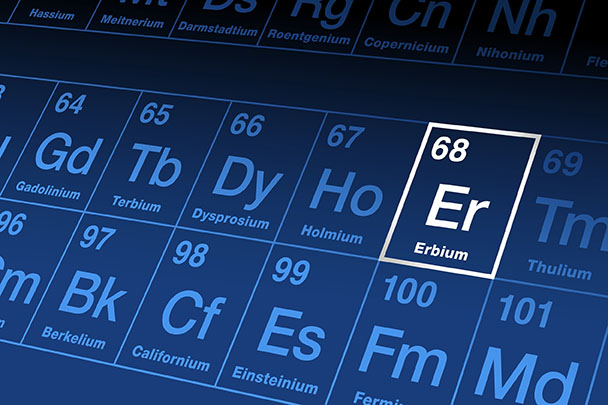
< Back
erbium
Definition
Erbium is a rare-earth element with the atomic number 68. It is a silvery-white metal that is found in the minerals monazite and bastnasite. Erbium is a member of the lanthanide series, which is a group of 15 elements that are chemically similar to each other.
Erbium is a soft, ductile metal that is a good conductor of heat and electricity. It is also a strong magnet. Erbium has a number of unique properties that make it useful in a variety of applications.
One of the most important properties of erbium is its ability to absorb and emit light. This property makes erbium useful in lasers and fibre optics. Erbium lasers are used for surgery and for telecommunications. Fibre optics that contain erbium are used to amplify light signals.
Erbium is also a strong magnet. This property makes erbium useful in magnetic materials. Erbium magnets are used in a variety of applications, including magnetic resonance imaging (MRI) machines and hard drives.
Erbium is also a good conductor of heat and electricity. This property makes erbium useful in a variety of applications, including electronic devices and batteries.
Erbium is a relatively rare element, but it is found in a number of minerals. The main sources of erbium are monazite and bastnasite. Monazite is a phosphate mineral that is found in beach sands. Bastnasite is a carbonate mineral that is found in sedimentary rocks.
Erbium is a valuable resource that has a number of important applications. It is likely that the demand for erbium will continue to grow in the future.
How can the word be used?
Erbium is a chemical element with the symbol Er and atomic number 68.

Different forms of the word
Noun: erbium, erbium metal.
Adjective: erbium, erbium-based, erbium-doped.
Verb: to erbium-dope.
Synonyms: lanthanide, rare-earth element.
Etymology
The word "erbium" comes from the Swedish town of Ytterby, where it was first discovered in 1843 by Carl Gustaf Mosander. The town's name is derived from the Swedish word "ytterst," meaning "outermost.".
Question
What is erbium?
AQA Science Exam Question and Answer
Question:
Explain the significance of erbium in the field of science and its applications. Describe the properties and uses of erbium as a rare earth element. Provide examples of how erbium is utilised in technology, such as lasers and optical amplifiers, and its role in enhancing communication and medical imaging.
Answer:
Erbium is a rare earth element with significant importance in the field of science and technology. It possesses unique properties, making it valuable in various applications. One of the most notable uses of erbium is in lasers and optical amplifiers. When combined with other elements, erbium-doped materials emit light at specific wavelengths, enabling their application in fibre-optic communication systems and amplifying optical signals without distortion.
In fibre-optic communications, erbium-doped amplifiers play a crucial role in extending signal transmission distances and improving data transfer rates. Additionally, erbium is employed in medical imaging, particularly in laser-assisted surgeries and magnetic resonance imaging (MRI) techniques, where it enhances the resolution and sensitivity of imaging systems.
Erbium's versatility and ability to interact with light and other materials make it an essential component in modern technologies, revolutionising communication networks and advancing medical diagnostics and treatments. Its unique properties continue to drive innovations in science and technology, contributing to the progress of various industries.